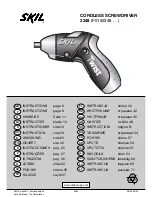
Follow very carefully the instructions in this manual, save it
and keep close at hand, ready to carry out any inspection of
parts that may be necessary.
If the machine is used carefully and normal maintenance is
carried out, it will work well for a long time.
The functions and use of the tool you have bought shall be
only those described in this manual. Any other use of the tool
is strictly forbidden.
ILLUSTRATIONS
DESCRIPTION (See figures)
A Safety screw (Fig.)
D Machine neck (Fig.)
E Drill-hammer button (Fig.1)
F Cooling vents (Fig.1)
G Depth stop (Fig.1)
H Auxiliary grip (Fig.1)
I Turn direction lever (Fig.1)
J On-/off switch (Fig.1)
K Retainer button (Fig.1)
L Key-operated drill chuck (Fig.)
M Drill chuck key (Fig.)
O Label for reversing rotation R-L (Fig.1)
BRIEF DESCRIPTION
A mechanical percussion unit generates the power necessary
for hammer drilling in stone or concrete.
Use of the tool: These hammer drills can be used for hammer
drilling in stone, drilling in wood, metal as well as plastic,
and also for driving screws with driving bits installed in a key
chuck. Any other use not mentioned is not allowed.
Additional features of the hammer drill:
- Warning! This machine must not be used with hole
saws, core bits, diamond bits, etc, as these tend to jam easily
in the orifice and can cause accidents.
- Change direction of rotation with switch lever I due to a
lockout mechanism, switching the lever is only possible if the
On/off switch J is not depressed.
TECHNICAL DATA
- Electronic control of spindle speed, infinitely variable by
finger pressure on the On/off switch J.
- For continuous operation the On-/Off switch can be
locked in the “On” position by the button K.
- Adjustable auxiliary handle H, with integral depth gauge
G.
BEFORE USING THIS TOOL
WARNING! Before carrying out any work, check, for instance,
using a metal detector, that there are no electric wires or gas
or water pipes under the surfaces you wish to work on.
Make sure the mains voltage is correct: it must be the same
as that on the specification label. Machines with 230V can
also be connected to a 220V mains supply.
To turn the machine on, press the ON/OFF switch J and keep
it pressed down.
When the ON/OFF switch is released, the machine stops.
WARNING! Always disconnect the plug from the socket
before doing any work on the machine.
1. Drill chuck
These models feature key-operated drill chucks L.
Changing drill chucks (Fig.)
Quick fitting drill chuck
Insert it in the tool and tighten with drill chuck key M uniformly
on each of the three holes.
Remove the drill chuck by opening it all the way and
completely unscrewing screw A.
WARNING: Screw A has lefthand threads.
Hold the shaft at gap C with a wrench and turn the drill chuck
in the opposite direction of operation.
. Changing the position of the auxiliary handle
1. Unscrew the auxiliary handle H in an anticlockwise
direction.
. Turn the auxiliary handle H to the required position.
. Screw the auxiliary handle H in place again.
. Setting the depth gauge
Make sure before you start that drill-bit is inserted.
1. Hold the bit tip against the work surface. Push the depth
gauge G against the work surface, to the same depth as the
Hammer drill
DHF13/580ER
DHF13/650ER
DHF13/750ER
DHF13/780ER
Rated power
W
580
600
750
750
No load speed
/min
0-3000
0-2800
0-2900
0-2800
Work shaft thread
UNF
1/2”x20
1/2”x20
1/2”x20
1/2”x20
Drill chuck capacity
mm
1,5…1
1,5…1
1,5…1
1,5…1
Max. steel capacity
mm
1
1
1
1
Max. wood capacity
mm
20
30
30
30
Max. concrete capacity
mm
1
1
1
16
N strikes in load
/min.
45000
30000
45000
30000
Acoustic pressure
dB(A)
96
93
96
95
Sound-power level
dB(A)
107
104
107
106
Vibration acceleration
m/s²
18,6
1,7
19,5
14,0
Weight according EPTA-
Procedure 01/2003
Kg.
1,9
,1
,
,





































